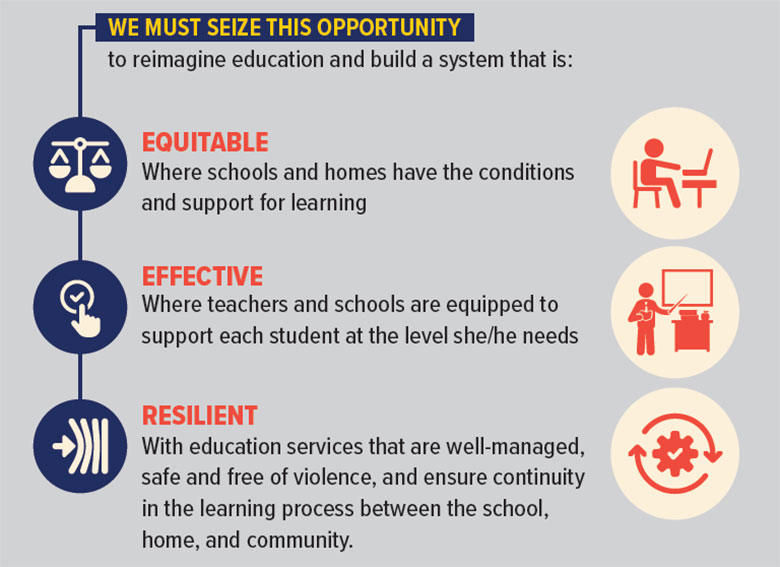Sutil, who lives in a remote village in West Kalimantan, Indonesia (the world’s 4th most populous country), has found educating his child during COVID-19 to be a monumental challenge. As a farmer with a lack of electricity and no access to the internet or television, Sutil has found it difficult to help his child with his lessons. Once a week, teachers come to the children’s homes so they can help the children with their learning, however, in many cases, they have difficulties finding the children because they are out with their parents in the rice fields.
Rosa is a teacher in Bekasi, Indonesia. Her daughter attends a private school and is accessing online learning several hours a day. But she finds that juggling her job with family responsibilities, and the poor internet connectivity make teaching and learning so much harder during COVID-19.
These challenging experiences are happening in countries across the world. Some of the most privileged students and teachers have been able to cope with the changes after schools closed, but not the majority.
This different education service, over many months, has the potential of having a huge negative impact on students’ skills and economic prospects for the rest of their lives. The World Bank has, from the very start of the pandemic, been working with countries to support them in addressing this crisis.
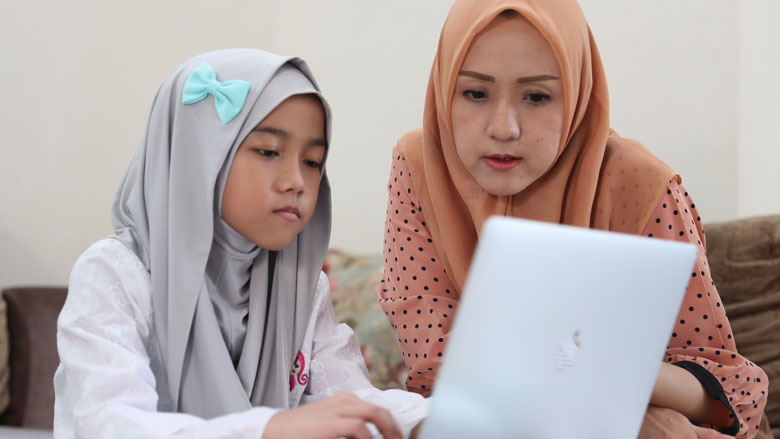
COVID-19 has created the worst crisis to education and learning in a century
COVID-19 is wreaking havoc on the lives of young children, students, and youth. The disruption of societies and economies caused by the pandemic is aggravating the pre-existing global education crisis and is impacting education in unprecedented ways.
Even before COVID-19 hit, the world was experiencing a learning crisis. 258 million children of primary- and secondary-school age were out of school, and the Learning Poverty rate in low- and middle-income countries was 53 percent – meaning that over half of all 10-year-old children could not read and understand a simple text. In Sub-Saharan Africa, the figure was closer to 90 percent.
At the peak of school closures in April 2020, 94 percent of students – or 1.6 billion children – were out of school worldwide, and, still, around 700 million students today are studying from home, in a context of huge uncertainty and with families and schools having to navigate across options of hybrid and remote learning, or no schooling at all. In the vast majority of countries, there is no end in sight to this uncertainty. Early evidence from several high-income countries has already revealed learning losses and increases in inequality.
Most early childhood education institutions are closed. And
Adding to this global shock to education systems is the negative impact of the unprecedented global economic contraction on family incomes, which increase the risk of school dropouts, and also results in the contraction of government budgets and strains on public education spending. The extended school closures, together with this economic downturn, is a twin unprecedented shock to education.
Due to learning losses and increases in dropout rates, this generation of students stand to lose an estimated $10 trillion in earnings, or almost 10 percent of global GDP, and countries will be driven even further off-track to achieving their Learning Poverty goals – potentially increasing Learning Poverty levels to 63 percent.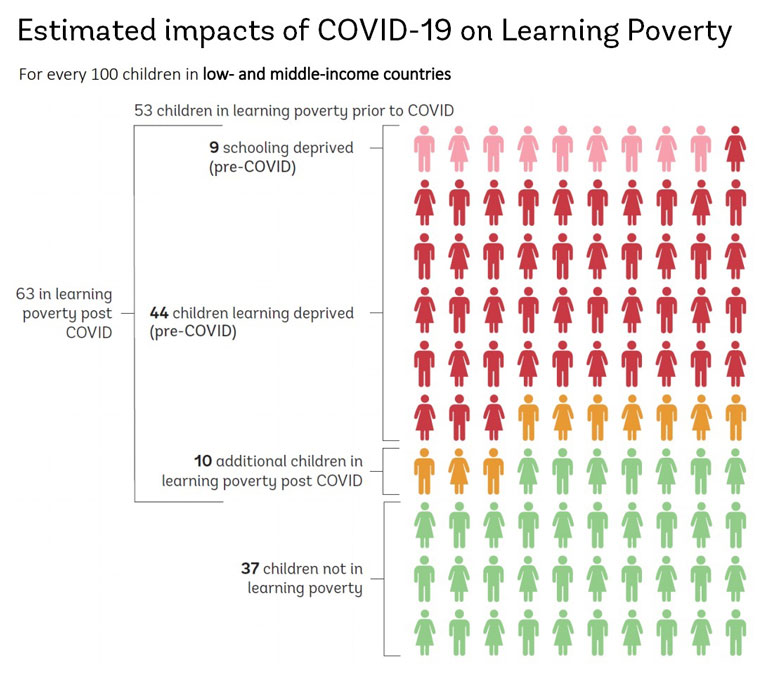
Source: Azevedo (2020). Pessimistic Scenario (of 70% of school closure, very low mitigation effectiveness, no remediation, and WB-MPO June). For more details on the simulation methodology, see Azevedo et al (2020)
Historical data and initial evidence from this pandemic suggest an inequality catastrophe in the making. Similar to the very different experiences Sutil and Rosa faced in 2020 in Indonesia, in all countries in the world we see immense differences in what rich and poor students experience. Vulnerable groups such as children with disabilities, ethnic minorities, refugees, and displaced populations are also less likely to access remote learning materials and to return to school post-crisis.
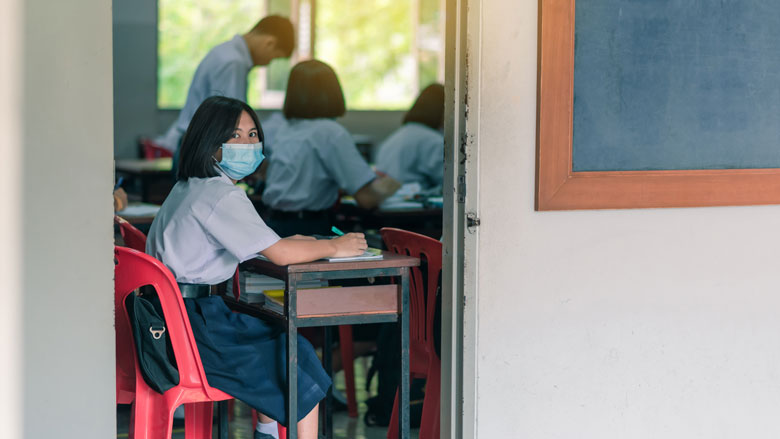
Tertiary education system is also in a deep crisis
At its peak, 220 million tertiary education students were impacted by closures of campuses globally. The tertiary education system is critical for countries’ growth. It is too soon to know the full impact on the declines and decreases in enrollment rates due to the pandemic, but severe losses of current and potential future students are expected.
Unprecedented disruption was also reported for Technical and Vocational Education and Training (TVET). According to the ILO-UNESCO-WB survey, 90 percent of respondents reported a complete closure of TVET centers in their countries as the continuity of practical skills training as well as assessment and certification of practical skills has been hit particularly hard due to the social distancing measures.
As a result, this generation of students, and especially the more disadvantaged, may never achieve their full education and earnings potential. This is not acceptable, and urgent and effective action is required to address these differential learning losses, which is critical to moving forward so that these gaps don’t widen.
Ramping up World Bank support to countries
The World Bank responded to the pandemic immediately, ramping up its support to countries through a variety of different channels and on different priority interventions. In all, the World Bank is supporting COVID-19 response investments in 62 countries, covering the entire cycle from early childhood to higher education. The Bank’s overall new commitments in education during the last fiscal year reached US$5.3 billion, the largest figure ever, and expects to add another US$6.2 billion this year. Our active portfolio surpasses $20.6 billion.
The World Bank’s education teams are working with countries along three phases of the COVID-19 response: i. Coping; ii. Managing continuity; and, iii. Improving and accelerating.
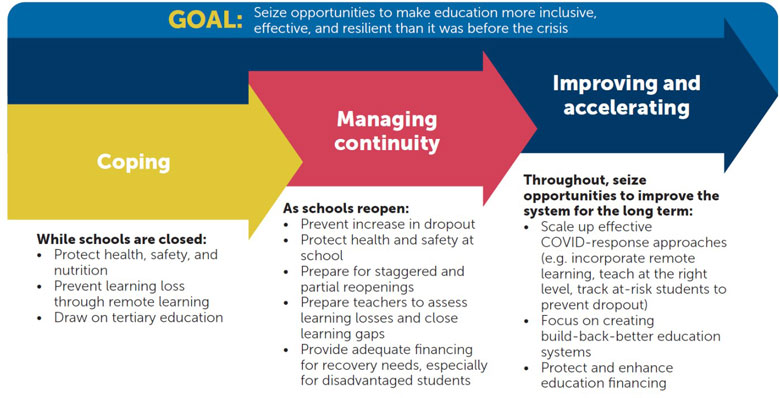 Source: World Bank 2020
Source: World Bank 2020
So far, World Bank efforts are reaching over 400 million students and 16 million teachers – about one-third of the student population and nearly a quarter of the teacher workforce in current client countries.
The World Bank is also providing just-in-time policy advisory support in 65 countries and are leveraging partnerships (with UNICEF, DFID, University of Harvard, University of Oxford, John Hopkins University, OECD, UNESCO, and others) to continue supporting country responses to the pandemic.
Our operational and policy support is not just responding to the crisis, but is building back better so that systems don’t replicate the problems that led to a learning crisis before COVID-19 and instead use this window of opportunity to shape more resilient systems, better prepared to cope with future shocks, as well as more equitable systems that ensure opportunities for all.
Bringing global knowledge and tools to the country level
A critical challenge of the response to the rapidly evolving crisis is providing up-to-date and evidence-based information to countries to support them in making the difficult decisions they face in addressing the COVID pandemic. The World Bank is supporting countries with this by providing them with tools and guidance on remote learning and school re-openings, such as a decision-making toolkit on remote learning options; remote learning assessment solutions; bringing reading materials to home; measuring the quality of teaching practices in the classroom and using these observations to provide continuous, practical support to teachers; identifying and developing teacher professional development solutions using EdTech, and building a compendium of structured lesson plans for teaching and uses of multimodal technology (TV, Radio, Mobile, digital content, and platforms).
Laying the groundwork for the future, now
Country challenges vary, but there is a menu of options for countries to choose from to cope with the pandemic shocks, to recover, and to lay the foundations to build back better, more resilient, and equitable education systems.
An urgent priority is to return to learning. Many countries are already managing flexible schemes in which schools open partially or close according to the sanitary conditions. It is a complex balance of managing health risks with the huge learning losses, particularly among the poor.
Specifically, there are 10 actions on which countries can take decisions to recover and accelerate learning:
- Assessing learning loss and monitor progress, when children return to school and during remote instruction;
- Providing remedial education and socio-emotional support to help students catch-up and ensure school retention;
- Restructuring the academic calendar, to adjust for lost school days due to the pandemic;
- Adapting the curriculum, to prioritize foundational learning (including social-emotional learning) accounting for the lost time;
- Preparing and supporting teachers, to manage burnout, improve digital skills, identify those students needing support and adjust instruction to meet them where they are at;
- Preparing and supporting school management, to develop and implement plans that ensure health and safety conditions for children’s return to schools and learning continuity;
- Communicating with stakeholders, to build ownership and support from parents/ caregivers, teachers, school staff and the broader community for school reopening plans;
- Encouraging re-enrolment, with special emphasis on at-risk of dropout populations;
- Minimizing disease transmission in schools, supporting campaigns for vaccination rollout and following epidemiological guidelines for sanitation and hygiene to prevent outbreaks, activation of remote instruction; and
- Supporting learning at home, by distributing books, digital devices where possible and resource packs for remote learning to children and parents.
Education technology can be a powerful tool to implement the above 10 actions by supporting teachers, children, principals, and parents; expanding accessible digital learning platforms, including radio/TV/Online learning resources (which is here to stay); and using data to identify and help at-risk children, personalize learning, and improve service delivery.
Looking ahead to the ‘Future of Learning’
While COVID-19 poses huge challenges, the crisis offers an opportunity to transform and reimagine education and to start realizing a vision for the Future of Learning where all children learn with joy, rigor, and purpose in school and beyond. In fact, this is a window of opportunity to reimagine education, with a vision of how schools will be shaped in the future – a future that has been propelled to today.
Countries can build on the lessons of the pandemic:
- The digital divide must be closed,
- We need to invest aggressively in teachers’ professional development and use technology to enhance their work,
- Parents play a critical role in their children’s education, and need to be supported in that role, and
- Resilient systems require better education conditions at home, devices, connectivity, and books.
The critical policy challenge is to make sure that this window of opportunity is not lost, and countries use this momentous crisis as THE opportunity to start seeing a turning point in addressing the learning crisis. The comprehensive reforms that are needed in each one of our client countries can be framed in the five-pillar approach, summarized recently in the Future of Learning report.

